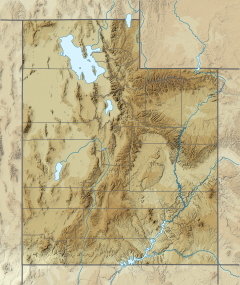Gobblers Knob is a 10,246-foot elevation (3,123 m) mountain summit located in Salt Lake County, Utah, United States.
| Gobblers Knob | |
|---|---|
 Southwest aspect, from Mt. Raymond | |
| Highest point | |
| Elevation | 10,246 ft (3,123 m)[1][2] |
| Prominence | 1,486 ft (453 m)[3] |
| Parent peak | Kesler Peak (10,403 ft)[4] |
| Isolation | 3.25 mi (5.23 km)[4] |
| Coordinates | 40°40′15″N 111°40′58″W / 40.6707431°N 111.6828869°W[5] |
| Naming | |
| Etymology | Gobbler |
| Geography | |
| Location | Mount Olympus Wilderness |
| Country | United States of America |
| State | Utah |
| County | Salt Lake |
| Parent range | Wasatch Range Rocky Mountains |
| Topo map | USGS Mount Aire |
| Geology | |
| Age of rock | Pennsylvanian[6] |
| Type of rock | Round Valley Limestone[6] |
| Climbing | |
| Easiest route | class 1 hiking[4] |
Description edit
Gobblers Knob is the highest point in the Mount Olympus Wilderness,[3] and is set on land managed by Wasatch National Forest. This peak is situated in the Wasatch Range which is a subset of the Rocky Mountains, and with Salt Lake City 12 miles to the west and Park City 10 miles to the east, it is a popular hiking destination.[7] Neighbors include Mount Raymond 1.5 mile to the southwest and Kesler Peak is 3.2 miles to the south. Precipitation runoff from the mountain's north slope drains to Mill Creek, whereas the south slope drains to Big Cottonwood Creek. Topographic relief is significant as the summit rises 3,240 feet (990 meters) above Mill Creek Canyon in 1.5 mile.
Climate edit
| Climate data for Gobblers Knob 40.6692 N, 111.6830 W, Elevation: 9,760 ft (2,975 m) (1991–2020 normals) | |||||||||||||
|---|---|---|---|---|---|---|---|---|---|---|---|---|---|
| Month | Jan | Feb | Mar | Apr | May | Jun | Jul | Aug | Sep | Oct | Nov | Dec | Year |
| Mean daily maximum °F (°C) | 29.4 (−1.4) |
29.6 (−1.3) |
35.2 (1.8) |
40.4 (4.7) |
50.0 (10.0) |
61.7 (16.5) |
71.0 (21.7) |
69.5 (20.8) |
60.3 (15.7) |
47.2 (8.4) |
35.7 (2.1) |
29.0 (−1.7) |
46.6 (8.1) |
| Daily mean °F (°C) | 21.0 (−6.1) |
20.5 (−6.4) |
25.5 (−3.6) |
30.4 (−0.9) |
39.6 (4.2) |
50.4 (10.2) |
59.6 (15.3) |
58.7 (14.8) |
50.0 (10.0) |
38.0 (3.3) |
27.2 (−2.7) |
20.6 (−6.3) |
36.8 (2.6) |
| Mean daily minimum °F (°C) | 12.6 (−10.8) |
11.4 (−11.4) |
15.8 (−9.0) |
20.3 (−6.5) |
29.1 (−1.6) |
39.0 (3.9) |
48.1 (8.9) |
48.0 (8.9) |
39.7 (4.3) |
28.7 (−1.8) |
18.7 (−7.4) |
12.3 (−10.9) |
27.0 (−2.8) |
| Average precipitation inches (mm) | 5.36 (136) |
4.64 (118) |
4.69 (119) |
5.10 (130) |
3.67 (93) |
1.91 (49) |
0.96 (24) |
1.36 (35) |
2.25 (57) |
3.24 (82) |
4.24 (108) |
4.83 (123) |
42.25 (1,074) |
| Source: PRISM Climate Group[8] | |||||||||||||
History edit
This mountain's toponym was officially adopted in 1964 by the United States Board on Geographic Names.[2] The landform's name "gobbler" refers to turkeys which miners of the Big Cottonwood Mining District tried raising when their mining income ceased, but this also failed as bobcats ate the turkeys.[9] In 1904, the Baker mine on the northwest slope produced gold ore and copper.[6]
See also edit
Gallery edit
References edit
- ^ United States Geological Survey topographical map - Mount Aire
- ^ a b United States Board on Geographic Names (1964), Decisions on Names in the United States, Decision List 6401, Department of the Interior, p. 55
- ^ a b "Gobblers Knob, Utah". Peakbagger.com. Retrieved 2022-08-14.
- ^ a b c "Gobblers Knob - 10,246' UT". listsofjohn.com. Retrieved 2022-08-14.
- ^ "Gobblers Knob". Geographic Names Information System. United States Geological Survey, United States Department of the Interior. Retrieved 2022-08-14.
- ^ a b c William T. Parry (2005), A Hiking Guide to the Geology of the Wasatch Mountains, University of Utah Press, ISBN 9780874808391, p.67
- ^ Julie Trevelyan (2016), 100 Classic Hikes: Utah, Mountaineers Books, ISBN 9781594859250
- ^ "PRISM Climate Group, Oregon State University". PRISM Climate Group, Oregon State University. Retrieved November 6, 2023.
To find the table data on the PRISM website, start by clicking Coordinates (under Location); copy Latitude and Longitude figures from top of table; click Zoom to location; click Precipitation, Minimum temp, Mean temp, Maximum temp; click 30-year normals, 1991-2020; click 800m; click Retrieve Time Series button.
- ^ Judy Jewell, W. C. McRae (2021), Moon Utah, Avalon Publishing, ISBN 9781640494749
External links edit
- Gobblers Knob: weather forecast
- National Geodetic Survey Data Sheet
- 2016 fatality: Utahavalanchecenter.org

